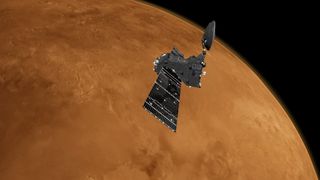3.11.2024
A signal beamed at Earth from Mars in 2023 has finally been decoded by a father and daughter team in the United States.

A radio signal beamed to Earth last year by ESA’s ExoMars Trace Gas Orbiter contained this image depicting five amino acids. Citizen scientists Ken and Keli Chaffin were the first to decode the image from the radio data. (Image credit: Ken and Keli Chaffin)
In 2023, a coded message was beamed at Earth from Mars. After over a year, this simulated extraterrestrial signal was finally decoded.
The European Space Agency's (ESA) ExoMars Trace Gas Orbiter Mars probe beamed the signal at us in May 2023 as part of "A Sign in Space," a multi-week art project led by Daniela de Paulis, the current Artist in Residence at the SETI Institute in Mountain View, California and the Green Bank Observatory in West Virginia. The project was intended as an experiment to test what types of techniques might be useful for decoding signals that might be detected as part of SETI (search for extraterrestrial intelligence) efforts.
After over a year, a father-daughter team has decoded that signal. Ken and Keli Chaffin were able to decipher the message after "following their intuition and running simulations for hours and days on end," according to an ESA statement.
Before the simulated alien signal could be decoded, it first had to be extracted from the raw radio signal data. That took just 10 days, thanks to a group of some 5,000 citizen scientists. But that was the easy part.
It took the Chaffins over a year to decode the signal. They finally found that it "contained movement," ESA wrote in the statement, which suggested to them that it might harbor information about cellular formation or life.
But decoding a signal doesn't necessarily mean that it can be understood. Now that the cryptic message has been decoded, citizen scientists like the Chaffins will have to begin attempting to interpret its contents and find possible meaning in it.

Amino acids as depicted in a radio signal beamed to Earth in 2023 by ESA's ExoMars Trace Gas Orbiter. (Image credit: ESA/Ken and Keli Chaffin
And that's the overall goal of the A Sign in Space Project. "Receiving a message from an extraterrestrial civilization would be a profoundly transformational experience for all humankind," de Paulis said in a 2023 statement describing the project.
"A Sign in Space offers the unprecedented opportunity to tangibly rehearse and prepare for this scenario through global collaboration, fostering an open-ended search for meaning across all cultures and disciplines."
But interpreting a message of true alien provenance could prove much, much harder, if it ever happens. Any simulated messages like the one beamed to Earth from the ExoMars Trace Gas Orbiter were created by humans and thus will embody how we view the universe and communicate our experience of it.

All our ideas about language, data, information and communication are rooted in how physics work on Earth, how human sensory organs perceive the world around us, how human languages have evolved, etc. It's hard for us to imagine how these same processes might work on an exoplanet harboring life, simply because we've never found or experienced one yet.
For all we know, alien communication might more resemble a collection of odors or the movements of a pile of leaves in the wind than anything we recognize as language.
Still, the search has to begin somewhere.
Projects like A Sign in Space offer useful thought experiments for planning how we might respond to the detection of a true alien radio signal. And the fact that this signal was decoded by citizen scientists shows exactly the type of out-of-the-box thinking that will likely be required when and if we ever receive that signal.
"More than astronomy, communicating with E.T. will require a breadth of knowledge," said Wael Farah, project scientist with the SETI Institute's Allen Telescope Array in northern California. "With A Sign in Space, we hope to make the initial steps towards bringing a community together to meet this challenge."
Quelle: SC
